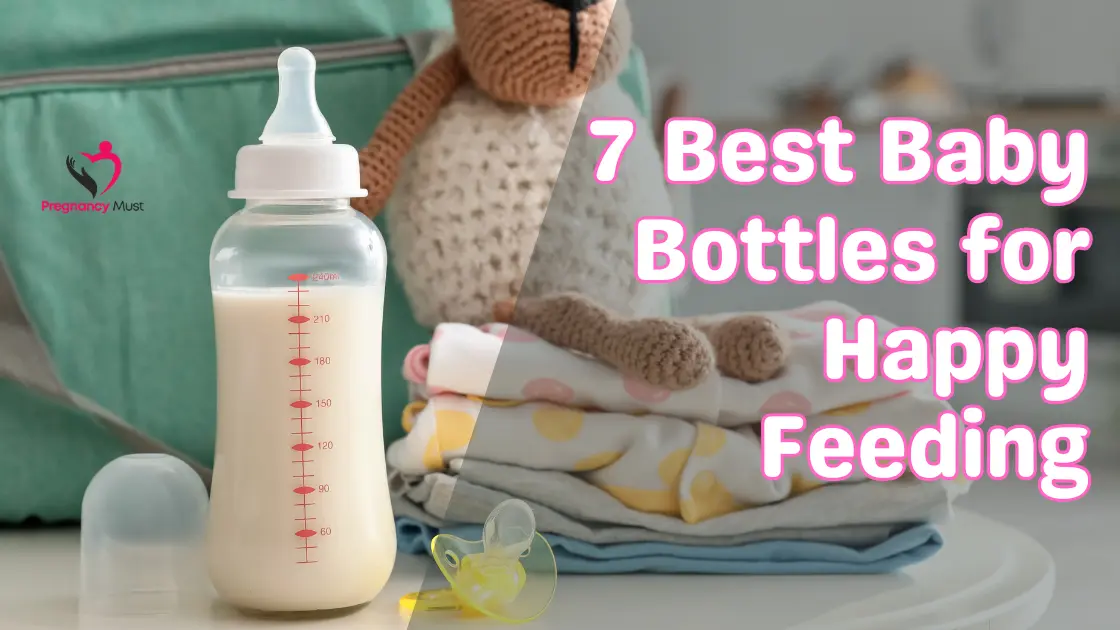The best baby bottles are far more than just a vessel for meals and nourishment—they’re a part of your baby’s feeding routine, whether you’re breastfeeding, pumping, or formula feeding.
Table of Contents
- Why Choosing the Best Baby Bottles Matters
- Different Types of Baby Bottles: Which One Fits Your Lifestyle?
- Best Bottles for Breastfed Babies: Making Life a Little Easier For Parents And Babies
- Top 7 Best Baby Bottles
- How to Clean and Sterilize Baby Bottles Safely
- Glass vs. Plastic Bottles: What’s Best for Your Baby?
- Tips for Choosing the Best Bottle for a Breastfed Baby
- When to Replace Baby Bottles and Nipples
- How Many Baby Bottles Do You Really Need?
- Best Baby Bottles for Traveling Moms
- Feeding Accessories to Pair with Your Bottles
- Common Mistakes When Using Baby Bottles
- Natural Transition: From Breast to Bottle
- FAQ – Best Baby Bottles
- Final Thoughts: Best Baby Bottles
Why Choosing the Best Baby Bottles Matters
As a new or expecting mom, the best baby bottles can make feeding time as smooth as possible, prevent colic, and in some cases, help your baby seamlessly transition from breast to bottle. Whether you are breastfeeding only, supplementing with formula, or formula-feeding, the right bottle can bring peace of mind.
Different Types of Baby Bottles: Which One Fits Your Lifestyle?
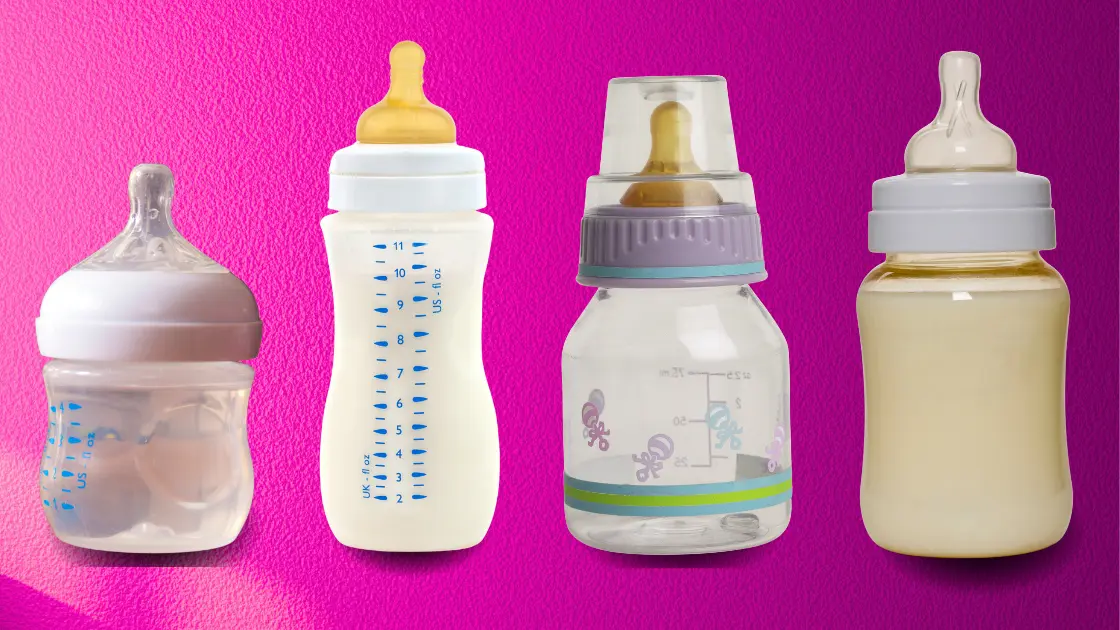
- Plastic Baby Bottles
Many parents prefer the use of plastic baby bottles because they are light and cheap. They are perfect during the busy days of Guess Who? The busy moms on the move or the frequent travelers. There is however, the need to be sure that the bottles are clearly marked as, BPA-free, in order to ensure that your baby is safe. Although plastic may scratch over time and absorb odors, high-quality brands now produce more durable, odor-resistant options that are dishwasher-safe.
- Glass Baby Bottles
The best glass baby bottles are known and appreciated for their durability, being totally free of any toxic chemicals, and they are easy to clean. They don’t leach toxins like plastic or hold on to smells. Glass bottles are generally heavier, though many include silicone sleeves to improve grip and reduce the chances of breaking. These bottles are perfect for the mom who puts hygiene, sustainability, and a more natural feeding solution at the top of her baby product checklist.
- Silicone Baby Bottles
These are soft, squishy and gentle in baby’s little hands. They are close to the experience of breastfeeding so are fantastic for mums who are combination feeding. The flexibility of silicone helps to create a better air flow and anti-colic feature. They are also inherently BPA-free making them of the safest material for drinking.
- Stainless Steel Bottles
Stainless Steel Bottles Sleek, stylish, and highly durable, stainless steel bottles are experiencing a surge in the hands of eco-minded mums and dads. They are also rust-resistant, hold temperature longer, and do not retain food odors. While pricier and less see-through (you may have trouble measuring if that matters a lot to you), they provide an ultra-safe, long-lasting option for baby feeding.
Best Bottles for Breastfed Babies: Making Life a Little Easier For Parents And Babies
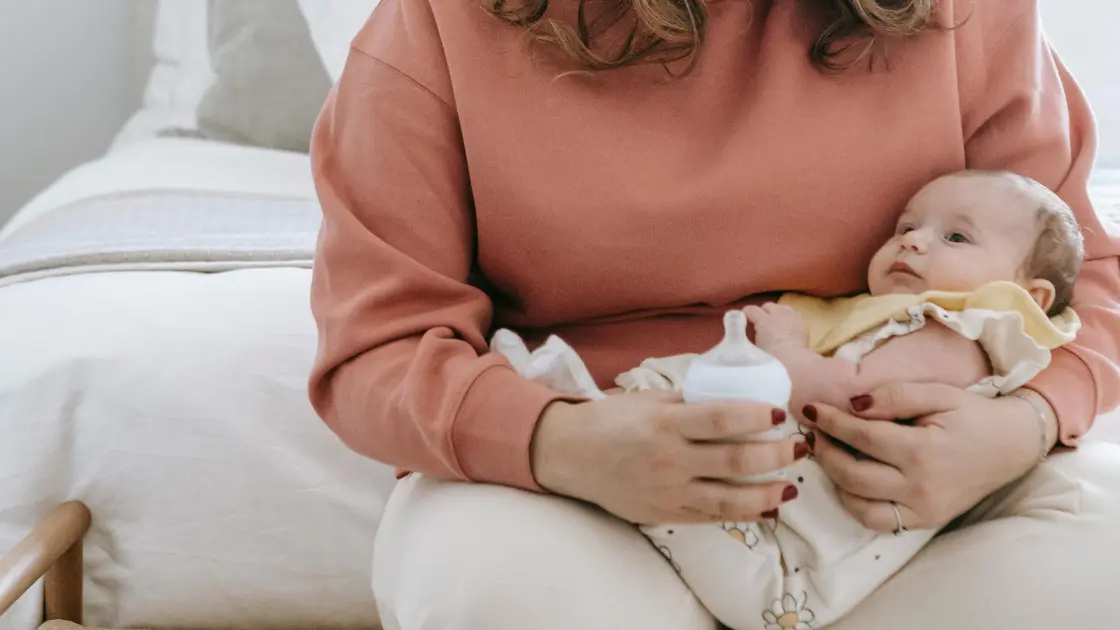
When baby transitioning between breast and bottle, consider bottles that most closely resemble the breast. Here are some factors to consider:
- Wide-Nipple Design
The best baby bottles for breastfed babies look and feel like a mother’s breast and have wide, soft, textured nipples. This kind of design supports a natural and comfortable latch, which decreases the likelihood of nipple confusion. It also promotes the same kind of sucking action used to breastfeed, which makes the transition easier for both baby and mom.
- Anti-Colic Vents
Anti-colic bottles feature vents that are integrated into the bottle to prevent vacuum buildup. By releasing air instead of mixing with the milk, they help ward off gas, spit-up and fussiness (meaning really you and your baby should thank them). Vented bottles often provide great results.
- Slow-Flow Nipples
Slow flow nipples are a must for breastfed newborns. They control milk flow similar to nursing to prevent over-feeding and choking. These nippes promote the natural suckling pattern baby use while nursing.. Baby can feed in a natural suck-swallow pattern making it lot more easier for baby to transition from breast to bottle and vice-versa.
Top 7 Best Baby Bottles
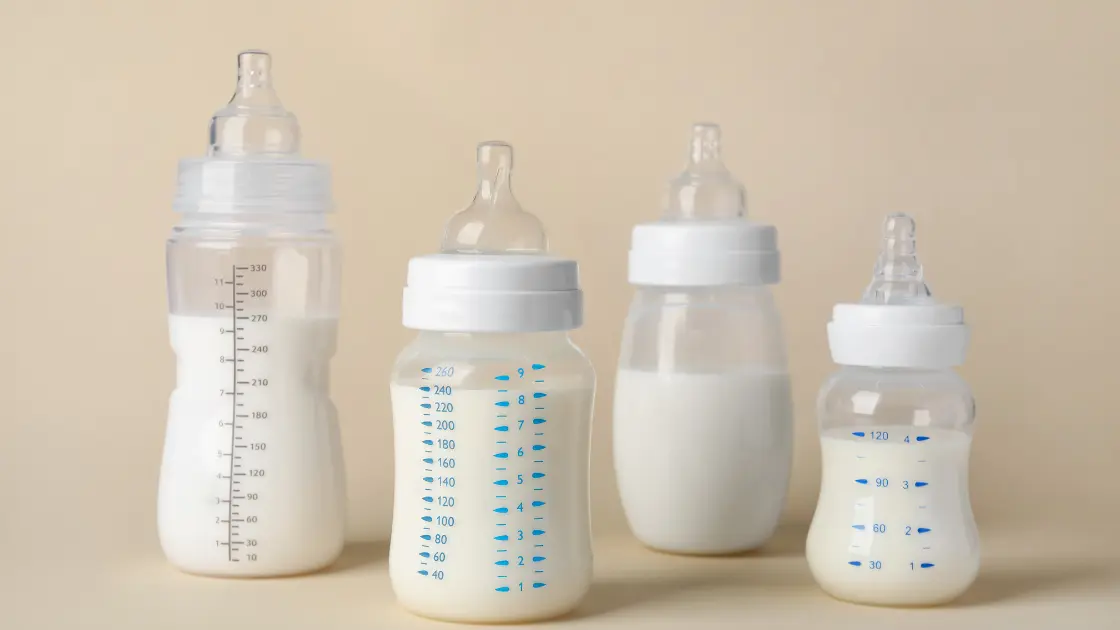
Here are the best baby bottles chosen by real moms, lactation consultants, and pediatricians:
- Philips Avent Natural Baby Bottle
The Philips Avent Natural has been consistently voted as the best bottle for breastfed baby, in part because of its breast-shaped nipple that promotes a natural latch. It features an integrated anti-colic valve to reduce air swallowing and gas. Constructed of BPA-free plastic, it is safe, durable, lightweight and easy to clean – a favorite for everyone!
- Dr. Brown’s Natural Flow
Renowned for its advanced internal vent system, Dr. Brown’s Natural Flow helps reduce colic, spit-up, burping, and gas. Its design preserves essential nutrients in milk and is suitable for both breastfed and formula-fed babies. Though the venting system is slightly more complex to clean, the comfort and health benefits make it well worth it.
- Comotomo Baby Bottle
Made of super-soft silicone, the Comotomo is a favorite for breastfed babies who refuse to take a traditional bottle. The wide nipple shape naturally feels like mom, and the easy-to-hold, removable handles make it seamless to go from nipple to bottle at feeding time. The wide, necked opening allows you to clean it with ease, and it is safe to heat in the microwave or clean in the dishwasher.
- Tommee Tippee Closer to Nature
Featuring an ultra soft silicone nipple and breast like shape, this bottle is perfect for easy transition from breast to bottle. It includes a built-in anti-colic valve and easy hold design makes it perfect for late night feedings. Parents appreciate its no-nonsense design and low maintenance.
- Evenflo Balance Plus Wide Neck Bottle
Crafted with lactation consultants, this bottle features a one-of-a-kind nipple shape that mimics the breast and a slow flow that breastfed babies love. It promotes healthy sucking habits and prevents choking, gas and mess. It’s BPA free and has a wide neck for easy cleaning and assembly.
- Lifefactory Glass Baby Bottle
This standout among the best glass baby bottles is crafted from thermal shock-resistant glass and protected with a grippy silicone sleeve. Eco-friendly, dishwasher-safe, and free of chemicals. Parents who want sustainable, safe and convenient feeding solutions will love the contemporary design.
- NUK Simply Natural Bottle
Mimicking breastfeeding, the bottle has multiple nipple holes (1-9) which provide a natural and realistic flow of milk for the baby. Its very soft nipple makes it easy for babies to transition back and forth between breast and bottle. The shape is particularly ergonomic, while the anti-colic air system is both very functional and comfortable.
How to Clean and Sterilize Baby Bottles Safely
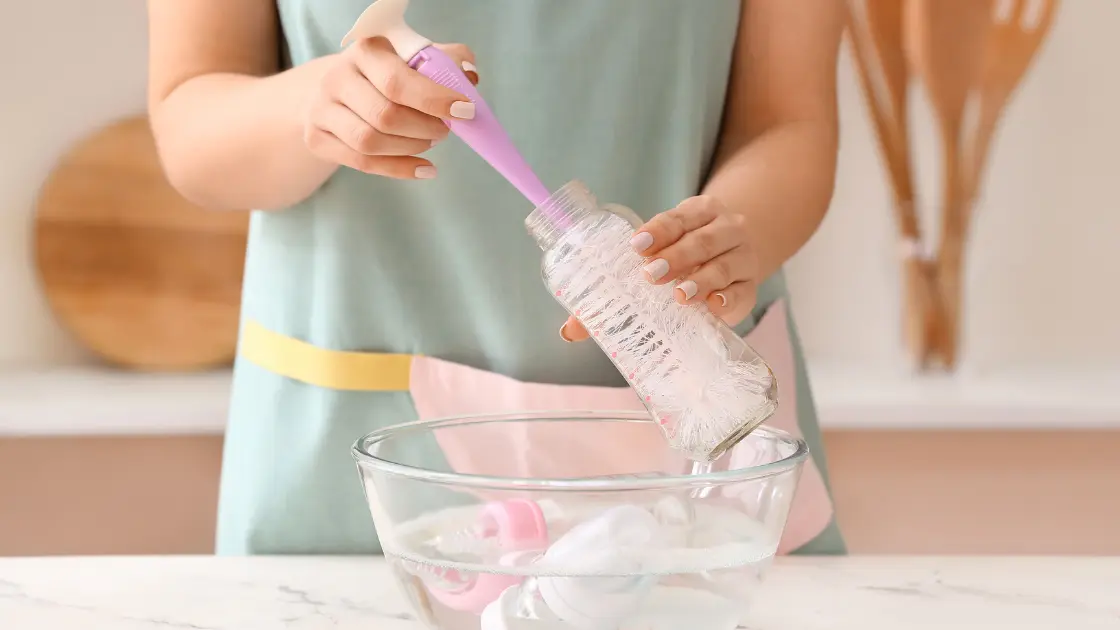
Proper hygiene is critical for newborn health. Here’s how to make sure your baby’s bottles are sparkling clean and germ-free every time.
Step-by-Step Cleaning Routine
- Disassemble bottles completely: Take the bottles apart. Separate all components such as nipple, ring, cap, vent insert (if applicable).
- Rinse thoroughly with cold water: This helps remove leftover milk residue before hot washing.
- Wash with hot water and baby-safe soap: Use mild, fragrance-free dish soap to gently clean each component.
- Use a bottle brush: Scrub the inside of the bottle and nipple using a dedicated bottle brush to reach all corners and crevices.
- Rinse and air dry: Let all parts dry completely on a clean drying rack—never with a shared kitchen towel to avoid contamination.
Sterilization Methods
- Boiling: Place disassembled parts in boiling water for 5 minutes. Carefully remove with sanitized tongs and air dry.
- Steam Sterilizer: An electric or microwave sterilizer uses high-temperature steam to kill 99.9% of germs in minutes. Ideal for regular daily use.
- Microwave Bags: Lightweight and portable, microwave sterilization bags are great for travel or quick home use—just add water, pop them in the microwave, and go.
No matter which method you choose, always inspect each part after sterilization for wear and tear to ensure continued safety and hygiene.
Glass vs. Plastic Bottles: What’s Best for Your Baby?
Feature | Best Glass Baby Bottles | Plastic Bottles |
Durability | High (with silicone sleeve) | Moderate |
Safety | No chemicals or BPA | Must be BPA-free |
Weight | Heavier | Lightweight |
Eco-friendly | Yes | No |
If sustainability and chemical-free feeding matter, the best glass baby bottles are a perfect choice. But for on-the-go feeding, plastic still works well—just check safety labels!
Tips for Choosing the Best Bottle for a Breastfed Baby
Choosing the best bottle for breastfed babies is about more than just grabbing a bottle off the shelf. Here’s what the experts say you need to know to begin and what to consider along the way:
- Choose a wide, breast-like nipple shape: This helps replicate the natural latch and sucking behavior developed during breastfeeding, reducing nipple confusion.
- Look for soft, slow-flow nipples to mimic breastfeeding: Soft silicone nipples with a slow flow prevent your baby from feeding too quickly and support a natural, breast-like rhythm.
- Make sure the bottle promotes paced feeding: Bottles designed with vented systems or angled shapes allow babies to control the flow better and encourage slower, more intentional feeding.
- Always choose BPA-free and easy-to-clean designs: Safety is crucial. Ensure the bottle is labeled BPA-free, and opt for wide-neck bottles or simple components that make cleaning and sterilizing easier.
When to Replace Baby Bottles and Nipples
Babies are tough on bottles; the normal wear and tear of regular use can cause bottles to look faded and worn even after just a few washes! The ability to replace bottles and nipples, when they are no longer appropriate for feeding, is an invaluable asset for ensuring feeding remains safe and sanitary.
- Cracks or discoloration appear: If you feel cracks, scratches, or a yellow tint in the bottle, you need to throw it away and get a new one. These may harbor bacteria even following a wash.
- Nipple gets too soft or starts leaking: A nipple that’s too flexible or leaky may cause feeding issues or pose a choking hazard. Replace it immediately.
- Every 3 months (general rule): As a best practice, most pediatricians recommend replacing both bottles and nipples every 2 to 3 months—even if they appear intact—to maintain hygiene and functionality.
How Many Baby Bottles Do You Really Need?
Most moms find 6–8 bottles sufficient for daily use, but your actual need can vary depending on a few personal factors. Here’s what to consider:
- Baby’s age: Newborns may feed more frequently, requiring more bottles ready to go. As your baby grows and begins solids, bottle use may decrease.
- Feeding method (breast vs. formula): Exclusively formula-fed babies usually need more bottles per day than breastfed babies. Pumping moms may need extras for milk storage.
- How often do you wash bottles? If you prefer not having to wash bottles every single time, it doesn’t hurt to have backups and get through the day without having to rush to wash a bottle. If you wash every time after a feeding you may need less bottles.
Best Baby Bottles for Traveling Moms
Traveling with an infant takes a bit of forethought, and the right bottle can make the job easier. Look for bottles that are:
- Leak-proof: No messes or spills when you are on the go, even in your diaper bag or carry-on luggage.
- Lightweight (plastic or silicone): These materials are convenient to pack and take on the go – perfect for a flight, road trip, or a day in the park.
- Compatible with formula dispensers or breast pumps: For added comfort, feeding on the go with a few additional accessories.
Feeding Accessories to Pair with Your Bottles
With the right accessories on hand, feeding your baby can be easy and efficient. Here’s some worth considering for your baby care toolbox:
- Bottle warmers: Keep your baby’s bottles at the right temp on the go, so your baby can eat on their schedule, too.
- Sterilizers: Because you will need to sterilize bottles, nipples, and the like if your baby is a newborn.
- Drying racks: Drying racks are used to dry bottle parts and keep them clean post-wash or sterilization.
- Travel bottle caps: Ideal for travel and keeping contents contained while in daycare or storing the bottle.
- Nipples in various flow rates: Each type of nipple is available, from slow to fast flow, to meet your baby’s needs as he or she grows and develops.
Common Mistakes When Using Baby Bottles
Even experienced parents can overlook bottle basics. Avoid these common pitfalls to ensure smoother, safer feeding:
- Using fast-flow nipples too early: This can overwhelm young babies and cause choking or overfeeding. Always match nipple flow to your baby’s age and needs.
- Not cleaning the vent system properly: Bottles with anti-colic vents need thorough cleaning to prevent clogs, leaks, and bacteria buildup.
- Switching bottle types too often (confuses baby): Consistency helps babies adapt. Introducing too many bottle shapes or nipple types may lead to refusal or feeding difficulties.
Natural Transition: From Breast to Bottle
Try offering the bottle when your baby is calm. Use expressed breast milk first, and have someone else give the bottle if the baby associates mom with breastfeeding.
FAQ – Best Baby Bottles
Q1: What are the best baby bottles for breastfed babies?
A: Bottles such as Comotomo, Philips Avent Natural, and Evenflo Balance that mimic the breast and support a good latch are the best baby bottles for breastfed babies.
Q2: Are glass bottles safe for babies?
A: Yes! The best glass baby bottles come with silicone sleeves to prevent breakage and are chemical-free.
Q3: Can I use different bottle brands together?
A: Yes! The best glass baby bottles are equipped with silicone sleeves to avoid breakage, and are chemical-free.
Q4: How do I know which flow nipple to choose?
A: Newborns need slow flow. As babies grow, so do their needs, but we know that doesn’t mean you need to have a new bottle every time they pass a milestone.
Q5: Do anti-colic bottles really work?
A: Yes, they reduce air intake, which lowers gas and discomfort. Dr. Brown’s and Tommee Tippee are top-rated for this.
Final Thoughts: Best Baby Bottles
Choosing the best baby bottles depends on your lifestyle, your baby’s feeding preferences, and your priorities—be it eco-friendliness, budget, or breastfeeding compatibility. Whether you need the best baby bottle for a breastfed baby or want the best glass baby bottles, this guide helps you pick with confidence.
Along with the best baby bottles, explore more on Pregnancy Must –
- Top 12 Best Diaper Bags: Stylish & Functional Picks for Parents
- Tummy Time Mat: 15 Power Mats to Boost Baby’s Strength
